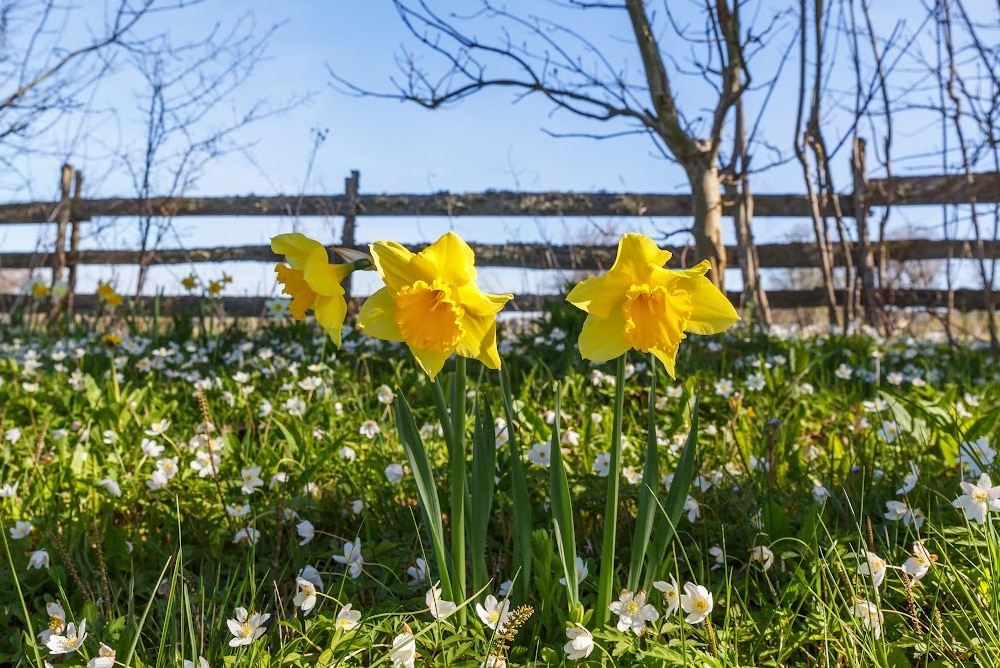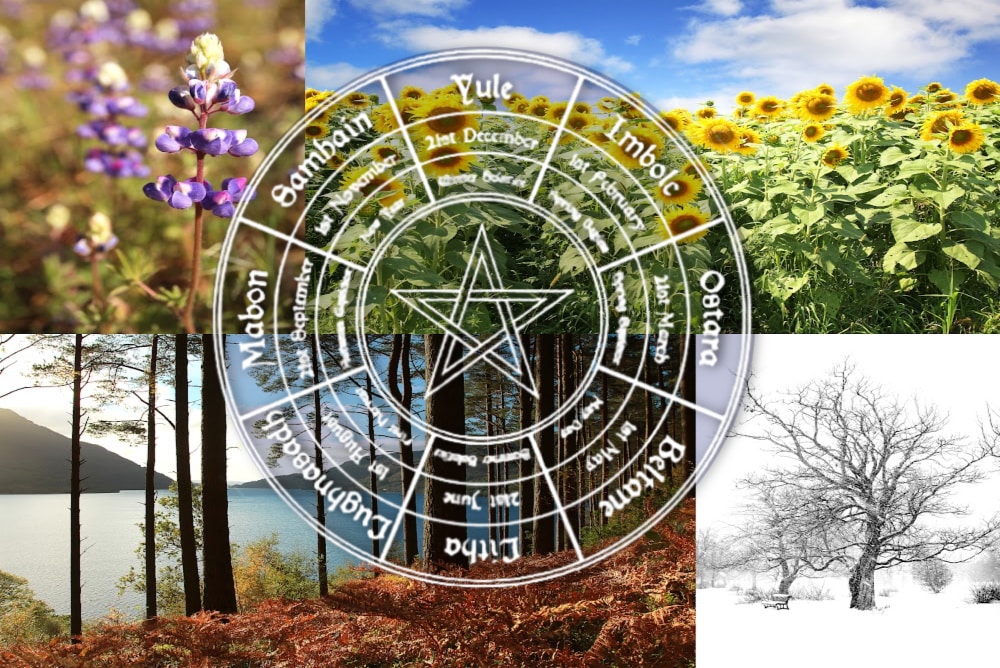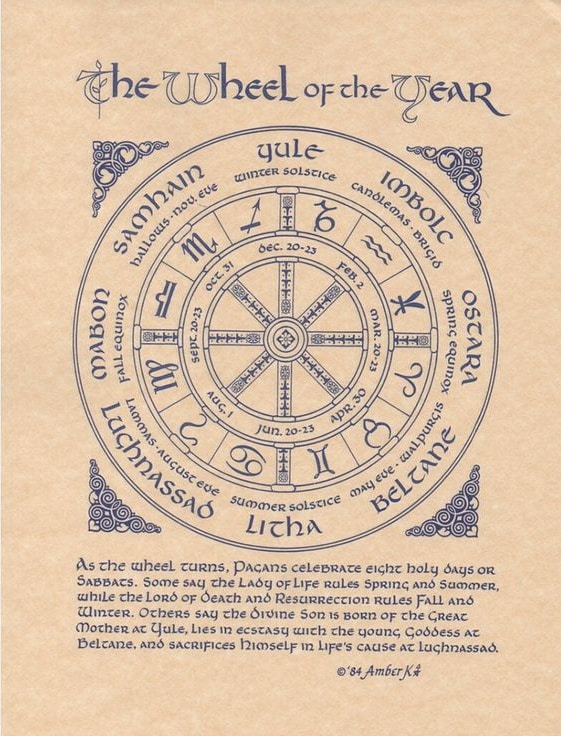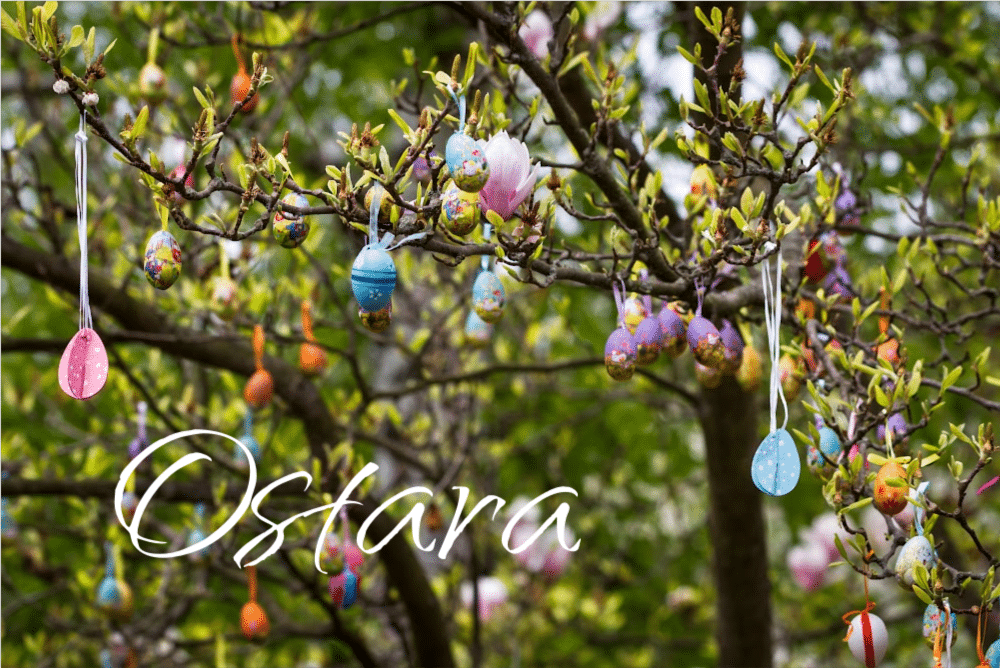The Wheel of the Year isn’t just a calendar; it’s a living, breathing cycle that carries us through the seasons, wrapping us in the ever-changing magic of nature. It’s the dance of the Earth and the cosmos, the story of birth, growth, death, and rebirth. It’s the heartbeat of the Goddess herself.
Eight sacred festivals, known as sabbats, mark the turning points of the Wheel of the Year. They are moments to pause, to celebrate, to honor the energies shifting around and within us. Rooted in ancient traditions and shaped by modern practices, these festivals remind us that we, too, are part of this great cosmic rhythm.
Maybe you’re just dipping your toes into the magic of the seasons, curious and seeking. Maybe you’re a seasoned witch, well-versed in the language of the sun and moon. Either way, this guide is here to walk the path with you. Inside, you’ll find:
- A deep dive into the eight sabbats and what makes each one unique.
- A goddess-centered approach to understanding the rhythm of the seasons.
- Practical, real-world ways to celebrate and align yourself with these energies.
- Symbols, correspondences, and sacred connections to deities.
- Links to rituals and deeper explorations of each sabbat to weave into your practice.
The Wheel of the Year is alive, and it’s calling to you. It’s a story written in the stars and whispered in the wind. It’s your invitation to step into the dance, embrace the magic, and walk hand-in-hand with the cycles of the Earth. So let’s begin.
What is the Wheel of the Year?
The Wheel of the Year is more than a way to mark time. It’s a rhythm, a pulse, a reminder that we are part of something bigger than ourselves. It’s an ancient dance, a cycle of eight sacred days that reflect the ebb and flow of nature’s energy. These days referred to as sabbats, guide us through the seasons, helping us align our lives with the shifts happening all around us.
Origins and Historical Roots
The roots of the Wheel of the Year run deep, winding through the traditions of the Celts, Norse, and Germanic peoples. Long before modern calendars, our ancestors lived by the land, measuring time by the length of days, the planting and harvesting of crops, and the movement of the sun in the sky. Their celebrations were tied to these natural rhythms, marking key turning points with festivals, feasts, and rituals that honored the land, the elements, and the divine.
Over time, these seasonal traditions blended and evolved, eventually forming the Wheel of the Year that many modern pagans and witches follow today. Though the names and details of these festivals may differ, the essence remains the same: a sacred journey through the cycles of birth, growth, death, and rebirth.
The Goddess and the Turning of the Wheel
At the center of the Wheel of the Year is the Goddess. She is ever-changing, shifting through her sacred cycle as the seasons turn. In spring, she is the Maiden, full of possibility and renewal. In summer, she flourishes as the Mother, abundant and powerful. As autumn arrives, she begins her descent, preparing for the quiet of winter, where she emerges as the Crone, keeper of deep wisdom and transformation.
While some traditions honor the divine masculine alongside the Goddess, this guide like my practice, takes a goddess-centered approach, focusing on her journey through the year and how we can align with her energy in our own lives as we observe the .
Why the Wheel of the Year Still Matters Today
Even in our modern world where many of us are disconnected from the land and the cycles of nature, we still feel the pull of the seasons. The long nights of winter make us crave rest and introspection, while the first blooms of spring bring a sense of renewal and energy. The shifts in nature mirror the shifts within us, whether we realize it or not.
By following the Wheel of the Year, we reconnect with that natural flow. It reminds us to slow down, to honor where we are, and to celebrate the journey. Whether it’s through small personal rituals, setting seasonal intentions, or simply noticing the way the light changes, working with the Wheel helps us step into alignment with the magic that is always surrounding us.

The Eight Sabbats: An Overview
Before we dive into each sabbat, it’s important to remember that these associations, symbols, and traditions you find here are not set in stone. Every practitioner’s journey with the Wheel of the Year is unique. While this guide provides a goddess-centered perspective and some commonly recognized correspondences, feel free to explore and discover which goddesses, god, colors, and rituals speak to you personally.
Many witches see Samhain as the Witch’s New Year, the point where the veil between worlds is at its thinnest and the cycle of life, death, and rebirth resets. It is a time to honor ancestors, reflect on the past year, and prepare for new beginnings. While Samhain begins the spiritual year, the Wheel of the Year continues its journey, guiding us through the seasons and the ever-turning dance of the Goddess.
The order of the sabbats in this guide follows the traditional calendar year, but this is not the only way to experience the Wheel. Some practitioners view the cycle beginning at Samhain, while others align it with personal spiritual markers. No matter where you begin, the Wheel keeps turning. What matters most is how the rhythm of the seasons speaks to you and how you choose to honor each turn of the Wheel.
As The Esoteric Cat grows, you’ll find links within each sabbat section leading to deeper explorations of rituals, deity connections, and practical ways to celebrate the Wheel of the Year. For now, take what resonates, and trust your intuition to guide you on this path.
🌱 Imbolc (February 1-2)
Imbolc is the festival of awakening, renewal, and inspiration. It marks the first stirring of life beneath the frozen earth as the days grow longer, hinting at the return of spring. This sabbat is a time to honor the Goddess in her Maiden aspect, lighting the first sparks of creation and setting intentions for what is to come.
Themes: Renewal, purification, new beginnings, inspiration
Goddess Associations: Brigid (Celtic), Vesta (Roman), Hestia (Greek)
Ways to Celebrate:
- Light candles or lanterns to welcome back the growing light.
- Perform a cleansing ritual for your home and spiritual space.
- Set intentions for personal growth and creative projects.
- Honor Brigid by working with poetry, crafting, or fire magic.
- Leave offerings of milk or honey as a symbol of nourishment and abundance.
Imbolc reminds us that even in the cold and darkness, new beginnings are stirring beneath the surface, ready to bloom when the time is right.
🌸 Ostara (March 20-21)
Ostara, also known as the Spring Equinox, the First Day of Spring, or the Vernal Equinox, is a time of balance, renewal, and fertility. Day and night stand as equals before the light begins its triumphant return, filling the world with the promise of growth and new life. The Goddess fully emerges as the Maiden, celebrating the awakening Earth as she steps into her full youthful power.
Themes: Balance, fertility, renewal, rebirth
Goddess Associations: Eostre (Germanic), Persephone (Greek), Flora (Roman)
Ways to Celebrate:
- Decorate your altar with eggs, flowers, and symbols of renewal.
- Plant seeds, both physically in a garden and metaphorically in your life.
- Meditate on balance and setting intentions for the active half of the year.
- Honor the Maiden aspect of the Goddess by embracing new beginnings.
- Dye eggs or engage in creative arts to celebrate fertility and creation.
Ostara is a time to step forward with hope, energy, and intention, embracing the return of warmth and light with open arms.
🔥 Beltane (May 1)
Beltane is a celebration of fire, fertility, and passion. It marks the peak of spring and the beginning of summer, a time when the Earth is bursting with life and energy. This sabbat is often associated with sacred union, both in the form of divine balance and personal relationships. Traditionally, it was a festival of fire, dancing, and revelry, embracing the full power of creation and desire.
Themes: Passion, creativity, fertility, union, celebration
Goddess Associations: Diana (Roman), Artemis (Greek), Rhiannon (Welsh), Freyja (Norse)
Ways to Celebrate:
- Dance around a Maypole, symbolizing the union of divine energies.
- Light a Beltane fire to honor the sun’s strength and passion.
- Work with flowers and herbs for beauty, attraction, and vitality.
- Engage in rituals of self-love and empowerment.
- Dedicate time to creative projects and embracing joy.
Beltane, a vibrant turning point on the Wheel of the Year, invites us to fully embody our desires and creative power, stepping into the warmth of the season with celebration and vitality.
☀️ Litha (June 21-22)
Litha, also known as Midsummer or the Summer Solstice, is the longest day of the year and a time of abundance, strength, and manifestation. The sun is at its peak, pouring energy into the Earth, making this a powerful time for growth, confidence, and setting intentions.
Themes: Strength, manifestation, protection, abundance
Goddess Associations: Amaterasu (Japanese), Sekhmet (Egyptian), Sol (Norse), Bastet (Egyptian)
Ways to Celebrate:
- Honor the power of the sun with bonfires and candle magic.
- Collect and work with herbs that are at their most potent.
- Perform solar blessings and gratitude rituals.
- Connect with water to balance the fire energy.
- Engage in divination to harness the energy of the season.
Litha is a time to stand in your power, embrace confidence, and honor the sun’s life-giving energy.
🌾 Lammas / Lughnasadh (August 1)
Lammas, also known as Lughnasadh, is the festival of the first harvest, marking the beginning of reaping what was sown earlier in the year. This is a time of gratitude, community, and recognizing abundance, while also preparing for the darker half of the year.
Themes: Harvest, gratitude, transformation, preparation
Goddess Associations: Demeter (Greek), Ceres (Roman), Lugh’s Mother (Irish), Quan Yin (Chinese)
Ways to Celebrate:
- Bake bread or grain-based foods to honor the first harvest.
- Give thanks for abundance and share with others.
- Reflect on what you have manifested so far this year.
- Honor seasonal shifts with simple grounding rituals.
- Work with earth energy to prepare for personal transformation.
Lammas reminds us to honor our hard work while preparing for the cycle of release and reflection that autumn brings.
🍂 Mabon (September 21-22)
Mabon, also known as the Autumn Equinox and the First Day of Fall, is a time of balance, gratitude, and preparation for the coming darkness of winter. As a key turning point on the Wheel of the Year, day and night are once again equal, making this a moment of reflection, inner work, and honoring transitions.
Themes: Balance, gratitude, introspection, transformation
Goddess Associations: The Morrigan (Celtic), Persephone (Greek), Inanna (Sumerian), Modron (Welsh)
Ways to Celebrate:
- Create an autumn altar with apples, leaves, and symbols of the season.
- Reflect on what you are harvesting in your life.
- Perform balance rituals to prepare for the darker half of the year.
- Honor ancestors and the cyclical nature of life.
- Celebrate with seasonal foods and warm gatherings.
Mabon teaches us to embrace change, find gratitude, and prepare for the introspective months ahead.
🎃 Samhain (October 31 – November 1)
Samhain is the Witch’s New Year, marking the end of one cycle and the beginning of another. It is a time to honor death, ancestors, and transformation, as the veil between worlds is at its thinnest. This liminal time allows for deep connection with those who have passed, making it the most sacred of the sabbats.
As one of the most powerful points on the Wheel of the Year, Samhain invites us to reflect on the past and prepare for the future. It is a night of remembrance, divination, and profound spiritual work, where we honor our lineage and seek guidance for the journey ahead.
Themes: Ancestral connection, endings and beginnings, transformation, shadow work
Goddess Associations: Hecate (Greek), Hel (Norse), Kali (Hindu), Cerridwen (Welsh)
Ways to Celebrate:
- Honor ancestors with altars, offerings, and remembrance rituals.
- Perform shadow work and deep reflection.
- Engage in divination to receive guidance for the coming year.
- Celebrate with rituals of transformation and release.
- Hold a silent supper or gather with loved ones to share stories.
Samhain reminds us that death is not an end but a transformation, a doorway to renewal. It is a powerful time to connect with the unseen and honor the cycle of life.
❄️ Yule (December 21-22)
Yule, also known as the Winter Solstice and the First Day of Winter, is the longest night of the year and marks the rebirth of the sun. This is a time of hope, renewal, and returning light, as the days will slowly begin to grow longer from this point forward. Yule is a time for introspection, connection, and celebrating the warmth within as we embrace the stillness of winter.
Themes: Renewal, rebirth, introspection, hope, warmth
Goddess Associations: Cailleach (Celtic), Frigg (Norse), Holda (Germanic), Berchta (Germanic)
Ways to Celebrate:
- Light candles or a Yule log to honor the returning sun.
- Decorate with evergreens, holly, and mistletoe to symbolize life enduring through winter.
- Spend time in quiet reflection, meditation, or divination.
- Exchange gifts as a symbol of generosity and abundance.
- Prepare nourishing foods and gather with loved ones to celebrate the season.
Yule reminds us that even in the darkest times, light is always returning, bringing renewal and the promise of new beginnings as the Wheel of the Year now turns toward spring.
A Note for Our Southern Hemisphere Witches
These sabbats follow the traditional Wheel of the Year as it is observed in the Northern Hemisphere. However, if you are a witch in the Southern Hemisphere, the cycle is reversed to align with the seasonal changes of your region. For example, while the Northern Hemisphere celebrates Yule as the Winter Solstice in December, those in the Southern Hemisphere observe it in June. This shift ensures that the festivals remain connected to the natural world and its cycles.
Understanding these variations allows practitioners worldwide to honor the Wheel of the Year in a way that resonates with their local environment and personal path. No matter where you are, the turning of the Wheel invites you to embrace the rhythms of nature and the magic within each season.

Living the Wheel: How to Integrate It Daily
The Wheel of the Year is more than just a series of sabbats. It is a reflection of the ebb and flow of nature and the rhythms of our own lives. Just as the seasons shift from the rebirth of spring to the abundance of summer, from the preparation of autumn to the introspection of winter, we, too, experience cycles of growth, harvest, release, and renewal. Understanding these natural shifts allows us to move with the current of life instead of against it.
In the springtime of life, we embrace the energy of the Maiden, a time of new beginnings, inspiration, and exploration. The world awakens, and so do we, feeling the pull to learn, create, and expand. This is when we plant the seeds of what we hope to manifest, whether in our spiritual journey, creative projects, or personal development.
As the Wheel of the Year turns and we move into the summer of life, the Mother aspect emerges. This is the time of nurturing, growth, and bringing our dreams into reality. It is a season of action, passion, and abundance, where we pour our energy into manifesting and sustaining what we have begun. Just as the sun reaches its peak, we, too, find ourselves at the height of our power and potential.
When autumn arrives, we begin to shift into the Crone’s wisdom. This is a time of harvesting our efforts, reflecting on what we have learned, and preparing for the quieter months ahead. Just as the leaves fall and nature slows down, we are called to release what no longer serves us and embrace the wisdom of introspection. The Crone reminds us that all things like the Wheel of the Year must cycle, and through endings, new beginnings are always waiting.
Ways to Work with the Wheel Daily
- Seasonal Altar Work: Keep an altar that shifts with the seasons, incorporating colors, symbols, and offerings relevant to each phase of the Wheel of the Year.
- Mindful Nature Walks: Observe how the land changes throughout the year. Pay attention to plant life, animal behavior, and how you feel as the seasons shift.
- Journaling & Reflection: Track your moods, energy levels, and insights as you move through the seasons. What patterns emerge? How do they align with the Wheel of the Year?
- Daily Rituals & Small Acts of Magic: Sip herbal teas that match the season’s energy, light candles in honor of the changing light, or incorporate seasonal foods into your meals as a form of everyday magic.
- Honoring the Moon Phases: The Wheel of the Year is closely connected to the cycles of the sun and the moon. Working with both solar and lunar rhythms can deepen your spiritual practice.
The Wheel of the Year reminds us to honor the present moment while moving forward with intention. Let it be a source of wisdom, magic, and alignment in your everyday life.
However you choose to engage with the Wheel of the Year, remember that this is a living, breathing practice, not a rigid set of rules. Let your intuition and personal spiritual path guide you.

Your Path Forward
The Wheel of the Year is a sacred guide through the cycles of nature and personal transformation. Each sabbat offers a unique opportunity to align with the energies of the Earth and the Goddess, embracing both light and shadow, growth and release. However you choose to walk the Wheel, trust that you are always part of its rhythm.
The beauty of the Wheel of the Year is that it is not just an external cycle. It is a deeply personal journey that shifts with your own spiritual growth. As you walk this path, you may find yourself drawn more strongly to certain sabbats, specific seasonal energies, or particular goddesses. Your intuition will guide you to where your magic resonates the most.
Perhaps you feel most alive in the awakening of spring, filled with the Maiden’s energy of renewal and possibility. Maybe the abundance of summer calls you to step fully into your power like the Mother. Or perhaps the depths of Samhain’s introspection align with your soul’s need for shadow work and ancestral connection. The more you explore, the more your personal practice will evolve, deepening your connection to the Wheel of the Year.
Beyond the sabbats, the Wheel of the Year connects to many other aspects of spiritual practice. One of the most beautiful things about witchcraft is that it is a personal journey. There is no single path, only the one that feels right for you. Take what resonates, leave what does not, and trust your intuition to guide your practice.
If you are drawn to the wisdom of the Crone, shadow work and ancestral veneration may be key elements of your path. If you feel most connected during the light half of the year, you may work best with solar magic, manifestation, and personal empowerment. The Wheel of the Year is not just about marking the seasons but about aligning with the rhythms of life, energy, and transformation in a way that feels authentic to you.
The Esoteric Cat offers guidance on many aspects of witchcraft, from tarot and divination to deity work, ritual practice, and working with the elements. Explore and discover what calls to your spirit, and let the Wheel be your guide in finding your true path.
Let the Wheel of the Year be your compass, reminding you that each moment, each season, and each phase of life has its own magic. Embrace it, trust your intuition, and walk forward with confidence.
✨ Ready to explore deeper? Follow your curiosity into the world of The Esoteric Cat, where new wisdom and deeper mysteries await. ✨



